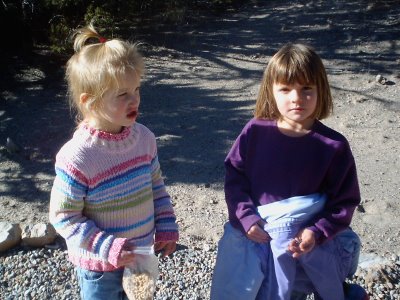The drive, about 26 miles from our house, is very beautiful with views of mountains, mesas and prairie. We often see wild horses grazing along with powerful looking Native American-owned bison.
The cone-shaped Tent Rock formations, that draw us here, were deposited by volcanic eruptions that occurred about 6 million years ago. They left pumice, ash and tuff deposits over 1,000 feet thick. Tremendous explosions from the Jemez volcanic field spewed pyroclasts (rock fragments), while searing hot gases blasted down slopes in an incandescent avalanche called a “pyroclastic flow.”
Precariously perched on many of the tapering hoodoos are boulder caps that protect the softer pumice and tuff below. The tent rock formations vary in height from a few feet to 90 feet.
Over time, wind and water cut into these deposits of tuff and pumice, creating canyons and arroyos.
During the 14th and 15th centuries, several large ancestral pueblos were established near Kasha-Katuwe and their descendants, the Pueblo de Cochiti, still inhabit the surrounding area. Kasha-Katuwe means “white cliffs” in the traditional Keresan language of the Pueblo.
This was a very interesting tree with most of it's roots above ground, which made for some fun climbing through, under and over.

Our friend, Karen beginning the Tent Rocks hike.

Jenna with Karen (holding baby Rick) on the slot canyon trail below a large boulder

Most of the kids climbing the pumice and volcanic tuff cliffsides

This section reminds me of a maze, how it twists and turns all around. Sometimes you can spy a head popping up in the trail ahead of you, only to watch it disappear again.

Jenna climbing in the slot canyon's trail. One of the trail warnings is to beware of flash flooding, which is how this slot canyon has been carved, as you can see in this photo. It's quite shocking to ponder over how the extreme forces of water can shape these beautiful canyons. You can be sure that I will avoid the canyon during monsoon season!

Here are Karen, her husband Al, and their new baby, Rick in a section of the slot canyon.

Jackson and Jeremiah enjoying their hike

Jackson, Ian and Jenna in the slot canyon.

Lana was very focused and driven to find the most 'Apache Tears'.

Jenna and Lana enjoyed hunting for "Apache Tears", Obsidian, on the trail. (See below for more information)

Jackson peeking behind an actual living tree arching across the trail, with a beautiful tent rock formation behind.

Jenna and Jackson were quite impressed with this natural living tree growing crooked across the trail.

Jack, Jeremiah, Ian and Jackson trying to stop this big boulder from crashing down!

Just another pretty view in the canyon.

Looks like Twins!

Jack, Karen's son enjoyed crawling up the tent rocks and made us all worry. And then he got 'stuck' way up on the saddle of a cliff. It took us almost 40 minutes to coax him down, along with Jackson's friendly support and help.

Jackson with a wall of tent rocks behind.

Some photos Jackson took of Jenna and I hiking back to the trailhead:


One favorite activity of ours is searching for "Apache Tears", or rather, Obsidian.
Obsidian is naturally ocurring glass created by volcanos, in areas where the lava cools rapidly. This rapid cooling prevents the growth of crystals. Because of the lack of crystal structure, obsidian blade edges can reach almost molecular thinness, leading to its ancient use as arrowheads, and its modern use as surgical scalpel blades.
Obsidian is also used for ornamental purposes, as a meditative stone and as a gemstone. When cut in one direction it is a beautiful jet black; when cut across another direction it is glistening gray
Of course, the obsidian we find at Tent Rocks is nicely rounded and not sharp. And they do resemble "Apache Tears". Click here: "The Legend of the Apache Tears" Not a great picture, but here's some of the 'Apache Tears' we brought home with us.


No comments:
Post a Comment